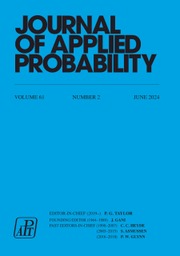Article contents
The Necklace Process
Published online by Cambridge University Press: 14 July 2016
Abstract
Start with a necklace consisting of one white bead and one black bead, and add new beads one at a time by inserting each new bead between a randomly chosen adjacent pair of old beads, with the proviso that the new bead will be white if and only if both beads of the adjacent pair are black. Let W n denote the number of white beads when the total number of beads is n. We show that EW n = n/3 and, with c 2 = 2/45, that (W n − n/3) / c√nis asymptotically standard normal. We find that, for all r ≥ 1 and n > 2r, the rth cumulant of the distribution of W n is of the form n h r . We find the expected numbers of gaps of given length between white beads, and examine the asymptotics of the longest gaps.
MSC classification
Information
- Type
- Research Article
- Information
- Copyright
- Copyright © Applied Probability Trust 2008
- 6
- Cited by

